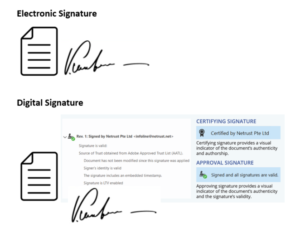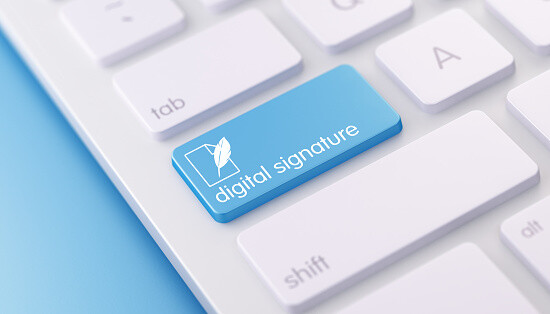Why the Need to Sign with a Digital Signature?
Electronic signing allows you to perform all signing operations remotely and from almost any device. All you need is an Internet connection. Plus, an electronic signature is just as legally binding as a handwritten one in ink on paper. Businesses are also switching to e-signature software solutions to reduce paper usage, cut costs, and increase efficiency. However, if you are new to the world of electronic signatures, you may be confused by the different terminologies for electronic signatures. For example, what is the difference between an electronic signature and a digital signature? To clarify, we will explain it all in this post.
Understanding the difference between Electronic Signature and Digital Signature

Electronic signature and digital signature are often used interchangeably, but in truth these two concepts are different. The main difference between the two is that digital signature is mainly used to secure documents and is authorized by certificate authorities, while electronic signature is often associated with a contract where the signer has the intention to do so.
Digital Signature’s Main Features
A digital signature is characterized by a unique feature embedded in a document in digital form like a fingerprint. The signer must have a digital certificate to be associated with the document. The digital signature is often authorized by certification authorities, which are responsible for issuing digital certificates that can be compared to driver’s licenses or passports. A digital certificate is used to validate the document to verify its authenticity if it has not been forged. This plays a crucial role in verifying the identity of the original person who signed it.
Another important feature of digital signature is that it is used to secure digital documents. There are people who tend to tamper with digital documents received online, but with a digital signature, this is impossible. The document is secured and can only be viewed by the authorized person for changes or additions.
When a digital signature is applied to a specific document, the digital certificate is combined with the data being signed to form a unique fingerprint. These two components of the digital signature are unique, and this makes them more practical than wet signatures because their origin can be authenticated. This cryptographic operation helps in performing the following functions:
– Proving the authenticity of the document and its source.
– Ensure that the document has not been tampered with
– Verifying the personal identity.
Another noteworthy aspect of the digital signature is that it consists of different types, supported mainly by two document processing platforms, Adobe and Microsoft.
Electronic Signature’s Main Features
An electronic signature is an electronic symbol, process or sound associated with a record or contract when the parties involved intend to sign the document. Thus, the main characteristic of an electronic signature is the intention to sign the document or contract. Another noteworthy aspect that distinguishes an electronic signature from a digital signature is that an electronic signature can be oral, a simple click of the box, or an electronically signed authorization.
The main characteristic of an electronic signature is that it indicates the signer’s intention to sign the document. This usually applies to contracts or other related agreements entered into by two parties. As mentioned earlier, there are different types of electronic signatures that are legally binding once all parties have expressed their commitment and intention to enter into a particular contract.
Another aspect of the electronic signature is that it helps to verify the document. Once it has been signed, its authenticity can be verified by identifying the parties involved. However, an electronic document can be difficult to verify because there is no digital certificate comparable to that of a digital signature.
The other notable feature of an electronic signature is that it is used to execute an agreement. For example, in a contract, two people usually agree to fulfil certain obligations, and this agreement can become legally binding only if it is signed by both parties. In this case, an electronic signature can be used. In addition, electronic signatures are often used in contracts because they are easy to use.
| Digital Signature | Electronic Signature |
| Used to secure a document | Used primarily to verify a document |
| A digital signature is authorized and regulated by certificate authorities | Usually not authorized |
| Includes more security features | Includes fewer security features |
| Common type of digital signatures are based on Adobe and Microsoft | The main types of electronic signatures include oral, electronically ticked or scanned signatures |
| A digital signature can be verified | An electronic signature cannot be verified |
| More preferred than electronic signatures because of the high level of authenticity | Easy to use but less authentic |
| Particularly concerned about the security of the document | Shows the intention to sign the contract |
Purpose
The main purpose of a digital signature is to secure a document so that it cannot be tampered with by unauthorized people.
An electronic signature is mainly used to verify a document. The source of the document and the authors are identified.
Regulation
Digital signatures are authorized and regulated by certification authorities. These are trusted third parties that are entrusted with the task of performing this function.
Electronic signatures are not regulated and are therefore less popular in various countries because their authenticity is questionable. They can be easily forged.
Security
A digital signature has more security features designed to protect the document
An electronic signature is less secure because it does not have viable security features to protect it from unauthorized tampering by others.
Types of signatures
Two common types of digital signatures are mainly based on document processing platforms, namely Adobe PDF and Microsoft
An electronic signature can come in the following forms: as a scanned image, verbally, or as a checkmark on an electronic document. The main idea behind it is to identify the person who signed the document for contractual purposes.
Verification
A digital signature can be verified to determine that the document has not been tampered with. A digital certificate can be used to identify the original author of the document.
It can be difficult to verify the actual owner of the signature because it is not certified. This affects both the authenticity and integrity of the document.
Intention
A digital signature is usually intended to secure a document so that it cannot be tampered with by unauthorized parties. Nevertheless, it is legally binding and preferred because it is authentic due to its traceability to the owner of the document.
An electronic signature usually shows the intention to sign the document or contract. In most cases, when people want to enter into a contract, they show their commitment by signing a document that becomes legally binding between them.
Conclusion
Which one should I choose?
Although both electronic and digital signatures are legally binding, you can choose one or the other depending on your needs. For example, if you are looking for a quick and cost-effective way to sign your PDF documents, electronic signatures are a great solution.
However, if you are dealing with important legal contracts or business agreements, you may need legal proof to back up the signed document. In this case, signing with digital signatures provided by nSign Digital Signing Suite is highly recommended.
The Best Digital Tools, Integration & Workflows for digital signing
Netrust nSign is a solution suite that further enhances your business application with digital signing capabilities on any files using Public Key Infrastructure (PKI).
Do contact Netrust Team to find out more on how we can protect your business at sales@netrust.net
Follow us on LinkedIn for the latest happenings/updates.


